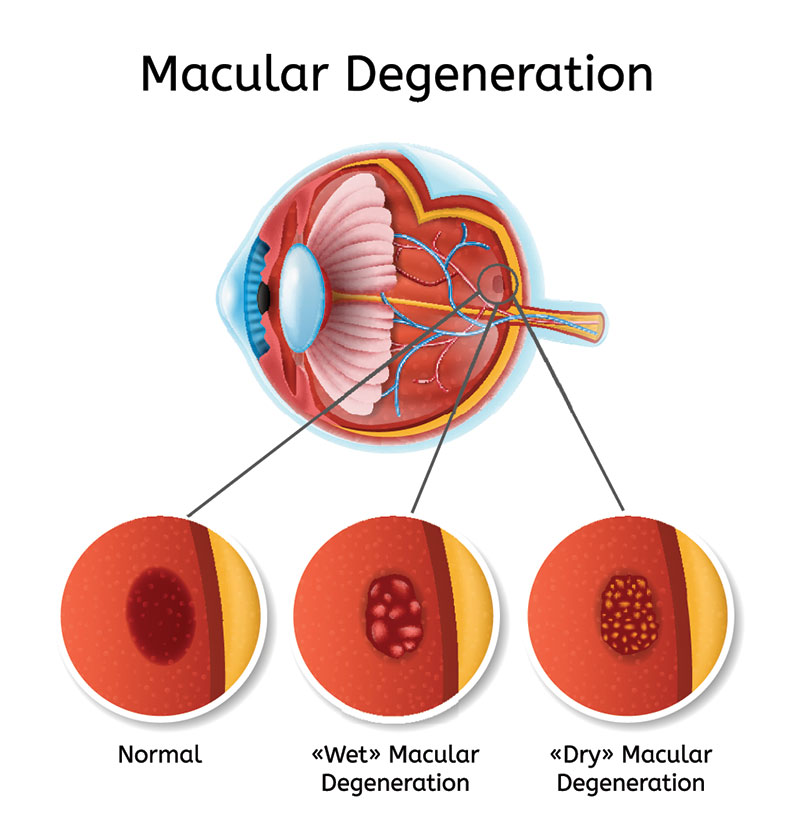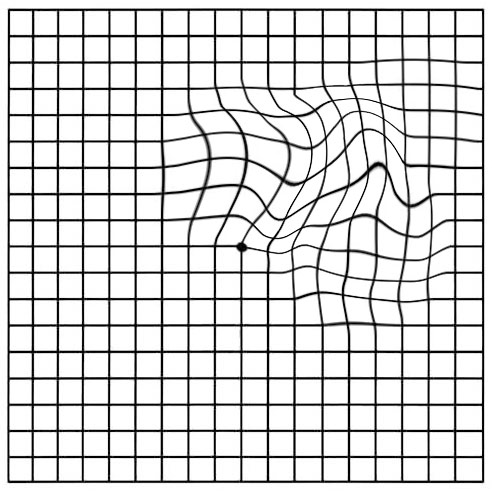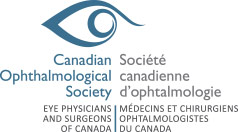For more information about eye conditions, special tests and general eye health, visit the American Academy of Ophthalmology website.
Age-related macular degeneration (AMD)
A common eye disease in older age, AMD affects your central vision.
Learn about AMD
- What is it?
- Causes
- Risk factors
- Diagnosis
- Treatment

Age-related macular degeneration (AMD) is one of the most common causes of poor vision after age 60. In fact, it accounts for 90% of new cases of legal blindness in Canada.
The macula is a small area at the centre of the retina in the back of the eye that allows us to see fine details clearly and perform activities such as reading and driving. AMD happens when the “seeing cells” in the macula break down or deteriorate.
The visual symptoms of AMD involve loss of central vision. While peripheral (side) vision is unaffected, with AMD, one loses the sharp, straight-ahead vision necessary for driving, reading, recognizing faces, and looking at detail.
There are two types of AMD: “dry” AMD and “wet” AMD.
Dry AMD
Nine out of 10 people who have AMD have atrophic or “dry” AMD. Dry AMD happens when the macula gets thinner and clumps of waste by-products accumulate beneath it. This causes you to slowly lose your central vision.
Wet AMD
Exudative or “wet” AMD is less common (affecting 1 out of 10 people with AMD) but is more serious.
In the wet form of AMD, abnormal blood vessels may grow in a layer beneath the retina. These vessels leak fluid and blood, scarring the macula. This causes a distortion and a large blind spot in the centre of your vision.
Promising AMD research is being done on many fronts. So far, research has resulted in the development of effective drugs to limit the damage from wet AMD and, in many cases, improve vision. Promising treatments for dry AMD are now entering clinical trials. In addition, high-intensity reading lamps, magnifiers and other low-vision aids help people with AMD to maximize their eyesight.
The causes of macular degeneration appear to be a mixture of genetics, aging and a mixture of other health and environmental factors.
Age is the most significant risk factor for developing AMD, but you may be more likely to develop AMD if you:
- Have blue eyes
- Have high blood pressure
- Have heart disease
- Have high cholesterol
- Smoke
- Are overweight
- Frequently eat foods high in saturated fat (e.g., butter, cheese)
- Have a family history of AMD
Early AMD changes can be detected at home with the use of an Amsler grid. Patients should test one eye at a time, covering the other eye and looking at the grid.
If the lines of the grid appear wavy, distorted or missing, the test is abnormal and the finding should be investigated by an optometrist or ophthalmologist.
How an Amsler grid appears to someone with AMD

Dry AMD Treatments
Dry AMD usually progresses slowly over many years. Studies do NOT show that the rate of deterioration changes with the use of your eyes for reading and other pursuits. A specific vitamin regimen based on the AREDS (Age-Related Eye Disease Study) has been shown to reduce the rate of people with advanced dry macular degeneration developing wet AMD. Several promising drugs are undergoing clinical trials.
Wet AMD Treatments
Because the “wet” type of AMD can lead to vision loss quickly, treating wet AMD is time-sensitive. Delays can result in poorer outcomes. This is why people with AMD need to check vision in each eye regularly (see above) and report changes without undue delay.
Wet-AMD is most commonly treated through injections of anti-vascular endothelial growth factor (anti-VEGF) drugs directly into the eye. These drugs are very effective at causing the abnormal blood vessels to become dormant and stop growing and leaking. Unfortunately, the effect of currently available drugs wears off and they need to be injected regularly to prevent recurrence and vision loss. With treatment we expect up to 90% of eyes to stabilize. Up to a third of eyes improve.
Download Brochure





